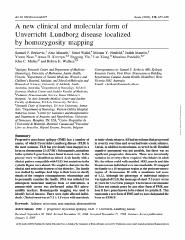Please use this identifier to cite or link to this item:
https://ahro.austin.org.au/austinjspui/handle/1/9850| Title: | A new clinical and molecular form of Unverricht-Lundborg disease localized by homozygosity mapping. | Austin Authors: | Berkovic, Samuel F ;Mazarib, Aziz;Walid, Simri;Neufeld, Miriam Y;Manelis, Judith;Nevo, Yoram;Korczyn, Amos D;Yin, Jinggang;Xiong, Lan;Pandolfo, Massimo;Mulley, John C;Wallace, Robyn H | Affiliation: | Epilepsy Research Centre and Department of Medicine (Neurology), University of Melbourne, Austin Health, Heidelberg West, Victoria, Australia | Issue Date: | 5-Jan-2005 | Publication information: | Brain : A Journal of Neurology 2005; 128(Pt 3): 652-8 | Abstract: | Progressive myoclonus epilepsy (PME) has a number of causes, of which Unverricht-Lundborg disease (ULD) is the most common. ULD has previously been mapped to a locus on chromosome 21 (EPM1). Subsequently, mutations in the cystatin B gene have been found in most cases. In the present work we identified an inbred Arab family with a clinical pattern compatible with ULD, but mutations in the cystatin B gene were absent. We sought to characterize the clinical and molecular features of the disorder. The family was studied by multiple field trips to their town to clarify details of the complex consanguineous relationships and to personally examine the family. DNA was collected for subsequent molecular analyses from 21 individuals. A genome-wide screen was performed using 811 microsatellite markers. Homozygosity mapping was used to identify loci of interest. There were eight affected individuals. Clinical onset was at 7.3 +/- 1.5 years with myoclonic or tonic-clonic seizures. All had myoclonus that progressed in severity over time and seven had tonic-clonic seizures. Ataxia, in addition to myoclonus, occurred in all. Detailed cognitive assessment was not possible, but there was no significant progressive dementia. There was intrafamily variation in severity; three required wheelchairs in adult life; the others could walk unaided. MRI, muscle and skin biopsies on one individual were unremarkable. We mapped the family to a 15-megabase region at the pericentromeric region of chromosome 12 with a maximum lod score of 6.32. Although the phenotype of individual subjects was typical of ULD, the mean age of onset (7.3 years versus 11 years for ULD) was younger. The locus on chromosome 12 does not contain genes for any other form of PME, nor does it have genes known to be related to cystatin B. This represents a new form of PME and we have designated the locus as EPM1B. | Gov't Doc #: | 15634728 | URI: | https://ahro.austin.org.au/austinjspui/handle/1/9850 | DOI: | 10.1093/brain/awh377 | Journal: | Brain | URL: | https://pubmed.ncbi.nlm.nih.gov/15634728 | Type: | Journal Article | Subjects: | Adolescent Adult Chromosome Mapping.methods Chromosomes, Human, Pair 12.genetics Disease Progression Electroencephalography Female Genotype Homozygote Humans Lod Score Magnetic Resonance Imaging Male Pedigree Unverricht-Lundborg Syndrome.genetics.pathology.physiopathology |
| Appears in Collections: | Journal articles |
Files in This Item:
| File | Description | Size | Format | |
|---|---|---|---|---|
| 15634728.pdf | 302.4 kB | Adobe PDF |  View/Open |
Page view(s)
32
checked on Nov 9, 2024
Download(s)
102
checked on Nov 9, 2024
Google ScholarTM
Check
Items in AHRO are protected by copyright, with all rights reserved, unless otherwise indicated.
